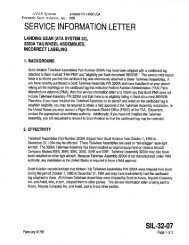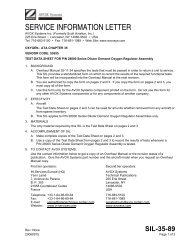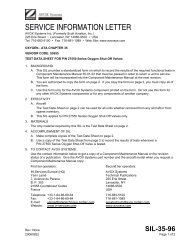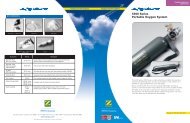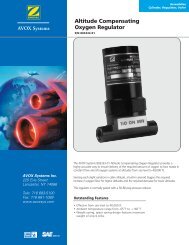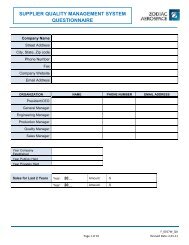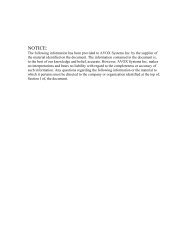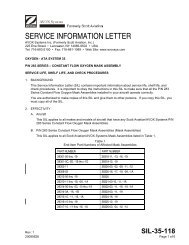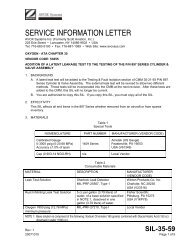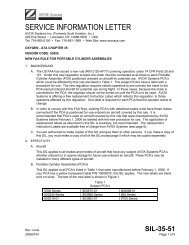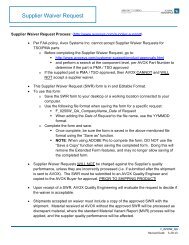Ammonia Inhalant MSDS - AVOX Systems, Inc.
Ammonia Inhalant MSDS - AVOX Systems, Inc.
Ammonia Inhalant MSDS - AVOX Systems, Inc.
Create successful ePaper yourself
Turn your PDF publications into a flip-book with our unique Google optimized e-Paper software.
MATERIAL SAFETY DATA SHEETJames Alexander Corporation 845 Route 94 Blairstown, NJ 07825Product Name: AMMONIA INHALANT SOLUTION<strong>MSDS</strong> Effective Date: September 10, 2004 Page 1 of 4CHEMTREC 24 Hour Emergency Phone: (800) 424-9300 Note: The CHEMTREC emergencynumber is to be used only in the event of chemical emergencies involving a spill, leak, fire, exposure, or accidentinvolving chemicals. All non-emergency questions should be directed to JAC at (908) 362-9266.------------------------------I. PRODUCT IDENTIFICATION -------------------------------Manufacturer’s Name: James Alexander Corporation Phone: (908)362-9266Emergency Telephone No.: (800)424-9300 (CHEMTREC)Address: 845 Route 94 Blairstown, NJ 07825Product Name: AMMONIA INHALANT SOLUTIONSynonyms: N/AD.O.T. Shipping Name: Air shipments: Flammable Liquid Corrosive NOS, 3- UN 2924, PGII(<strong>Ammonia</strong>, ethanol)Ground shipments: Consumer Commodity- ORM-DNFPA Ratings: Health - 3 Flammability - 3 Instability - 1------------------------------II. HAZARDOUS INGREDIENTS ---------------------------------------OSHA-------- ---------ACGIH---------Component CAS No. % PEL/TWA TLV/TWA TLV/STEL<strong>Ammonia</strong> 7664-41-7 17.5 50 ppm 25 ppm 35 ppmEthyl Alcohol 64-17-5 37.5 1000 ppm 1000 ppm Not listed---------------------------------------III. PHYSICAL DATA --------------------------------------Boiling Point: N/A for mixturesSpecific Gravity: 0.891 25/25Vapor Density: UnknownMelting Point: UnknownVapor Pressure: UnknownSolubility in water: Very soluble% volatiles by vol.: 55% Evaporation Rate (Butyl acetate=1): UnknownAppearance and odor: Clear, pink to light red liquid. Pungent odor of ammonia.pH: Unknown-----------------------IV FIRE & EXPLOSION INFORMATION ------------------------Flash Point: Less than 50 degrees F Test Method: Pensky Martens Closed CupAutoignition temp: <strong>Ammonia</strong> 1204 degrees F (651 o C); Ethyl Alcohol: 685 degrees F (363 o C)Flammable limits in air % by volume: Lower (Unknown)Upper(Unknown)Extinguishing media: “Alcohol resistant” foam, CO 2 or dry chemical.
MATERIAL SAFETY DATA SHEETJames Alexander Corporation 845 Route 94 Blairstown, NJ 07825Product Name: AMMONIA INHALANT SOLUTION<strong>MSDS</strong> Effective Date: September 10, 2004 Page 2 of 4CHEMTREC 24 Hour Emergency Phone: (800) 424-9300 Note: The CHEMTREC emergencynumber is to be used only in the event of chemical emergencies involving a spill, leak, fire, exposure, or accidentinvolving chemicals. All non-emergency questions should be directed to JAC at (908) 362-9266.Special fire fighting procedures:NOTE: Individuals should perform only those fire-fighting procedures for which theyhave been trained.Remove all sources of ignition. Move exposed containers from fire area if it can be donewithout risk. Firefighters should wear proper protective equipment and self-contained breathingapparatus with full facepiece operated in positive pressure mode. Spray extinguishing mediadirectly into base of flames. Water may be used to keep fire-exposed containers cool.Unusual fire and explosion hazard: When heated, mixture will give off ammonia gas, a strongirritant to eyes, respiratory tract, and mucous membranes. Other toxic gases produced are oxidesof nitrogen, carbon monoxide, carbon dioxide and hydrogen. Closed containers exposed to heatmay develop pressure and explode.Alcohol vapors are heavier than air and may travel a considerable distance to a source ofignition and flash back. Alcohols burn with a pale blue flame which may be extremely hard tosee under normal lighting conditions. Personnel may be able to feel the heat of the fire withoutseeing flames. Extreme caution must be exercised in fighting alcohol fires.-------------------------V. HEALTH HAZARD INFORMATION -------------------------Primary routes of exposure: Inhalation, eye contact, skin contact, ingestion.Signs and symptoms of overexposure:Inhalation: Irritation or burns of the respiratory system, headache, coughing, lungcongestion or inflammation, pulmonary edema, breathing difficulty. Headache, dizziness,drowsiness, loss of appetite and an inability to concentrate.Eye contact: Severe irritation or burns, may lead to blindness.Skin contact: Local irritation, dry skin, burns.Ingestion: Burning pain in mouth, throat, constriction of throat, coughing, followed bynausea, vomiting or diarrhea. Ingestion may prove fatal.Medical Conditions Aggravated by Exposure: Individuals with pre-existing nervous systemdisorders, skin disorders, eye problems, or impaired respiratory function may be moresusceptible to the effects of overexposure.----------------VI. EMERGENCY AND FIRST AID PROCEDURES ----------------For Inhalation: Remove subject immediately to fresh air. Give artificial respiration ifvictim is not breathing. If breathing is difficult, give oxygen. Get immediate medical attention.
MATERIAL SAFETY DATA SHEETJames Alexander Corporation 845 Route 94 Blairstown, NJ 07825Product Name: AMMONIA INHALANT SOLUTION<strong>MSDS</strong> Effective Date: September 10, 2004 Page 3 of 4CHEMTREC 24 Hour Emergency Phone: (800) 424-9300 Note: The CHEMTREC emergencynumber is to be used only in the event of chemical emergencies involving a spill, leak, fire, exposure, or accidentinvolving chemicals. All non-emergency questions should be directed to JAC at (908) 362-9266.For Eye Contact: Immediately flush eyes with copious amounts of water for at least 15minutes. Eyelids should be held apart and away from eyeball for thorough rinsing. Do not permitvictim to rub eyes. Get immediate medical attention.For Skin Contact: Immediately flush skin with copious amounts of water for at least 15minutes while removing contaminated clothing and shoes. Do not rub or apply ointment toaffected area. Obtain medical attention if irritation persists. Wash clothing before re-use.For Ingestion: Contact a Poison Control Center immediately. Do NOT induce vomiting.If conscious, have victim swallow large amounts of water. Do not give anything by mouth to anunconscious or convulsing person. Get immediate medical attention.-------------------------------------VII. TOXICITY DATA ---------------------------------------None of the components present in this formulation are currently classified ascarcinogens in the NTP Annual Report on Carcinogens, IARC Monographs or by OSHA.------------------------------VIII. PERSONAL PROTECTION ------------------------------Storage Requirements: Protect containers from physical damage. Detached or outsidestorage is preferred. Inside storage should be in an NFPA approved flammable liquids storageroom or cabinet. Store in corrosion-proof area at temperatures below 77 degrees F (25 o C). Donot store in direct sunlight. Isolate from incompatible materials. Keep containers tightly closed.Handling Requirements: All ignition sources should be eliminated. Remove closurecarefully; internal pressure may be present. Keep closure up to prevent leakage. When contentsare being transferred, metallic containers must be bonded to the receiving container andgrounded to avoid static discharges. Never use pressure to empty containers. Replace closurecarefully after each opening.Ventilation: Not required for product (JAC unit dose inhalant) use. When handling bulkmaterial, use general or local exhaust ventilation to meet TLV requirements. Where engineeringcontrols are not feasible or sufficient to achieve full conformance with acceptable exposurelimits, use NIOSH approved respiratory protection equipment. Care must be taken to assure thatany respirator chosen is capable of protecting the user from both ammonia and ethyl alcoholvapors. In some cases, a self-contained breathing apparatus may be advisable.Eye Protection: Not required for product (JAC unit dose inhalant) use. When handlingbulk material, always wear gas-tight, splash-proof chemical safety goggles meeting OSHA29CFR 1910.133 specifications.Skin Protection: Not required for product (JAC unit dose inhalant) use. Use rubbergloves, protective suit, face shield and overshoes when handling bulk product.
MATERIAL SAFETY DATA SHEETJames Alexander Corporation 845 Route 94 Blairstown, NJ 07825Product Name: AMMONIA INHALANT SOLUTION<strong>MSDS</strong> Effective Date: September 10, 2004 Page 4 of 4CHEMTREC 24 Hour Emergency Phone: (800) 424-9300 Note: The CHEMTREC emergencynumber is to be used only in the event of chemical emergencies involving a spill, leak, fire, exposure, or accidentinvolving chemicals. All non-emergency questions should be directed to JAC at (908) 362-9266.-------------------------------IX. HAZARDOUS REACTIVITY -------------------------------Stable at room temperature. Hazardous polymerization will not occur. However, productwill react exothermically with acids. Releases ammonia vapor when heated. <strong>Ammonia</strong>component will decompose to hydrogen and oxides of nitrogen when heated. Carbon monoxidegas may also be produced when heated.Conditions To Avoid: Sunlight, heat (heating above ambient temperatures causes thevapor pressure of the solution to increase).Avoid mixing with acids, most common metals, strong oxidizing agents, brass, zinc,chlorine, aluminum, copper, bronze, mercury, dimethyl sulfate and acetyl chloride.-----------------X SPILL, LEAK AND DISPOSAL PROCEDURES ------------------For large spills, stop leak if you can do so without risk. Extinguish all sources of ignition.Wear self-contained breathing apparatus, chemical safety goggles and full protective clothing.Ventilate area. Spilled liquids should be contained and not washed into sewers or ground water.Contain by diking with non-combustible absorbent materials and place residue in DOT approvedwaste container.Comply with all applicable local, state and federal regulations on spill reporting, handlingand disposal of waste.Other Precautions: Containers, even those that have been emptied, will retain productresidue and vapors. Handle empty containers as if they were full.Prepared By: David RobinsonTitle: Vice PresidentDate of Initial Preparation: June 1989Latest Revision Date: September 10, 2004------------------------------------------------------------------------------------------------------------------NOTE: This Material Safety Data Sheet is intended only as a guide to the appropriateprecautionary handling of the material by a person trained in, or supervised by a person trainedin, the safe handling of chemical materials. James Alexander Corporation (JAC), expresslydisclaims all express or implied warranties of merchantability and fitness for a particular purposewith respect to the product or information provided herein.All information appearing herein is based upon data obtained from the manufacturer(s)and/or recognized technical sources. While the information is believed to be accurate, JACmakes no representations as to its accuracy or sufficiency. Conditions of use are beyond JAC’scontrol and therefore, users are responsible to verify this data under their own operatingconditions to determine whether the product is suitable for their particular purposes and theyassume all risks of their use, handling, and disposal of the product, or from the publication or useof, or reliance upon, information contained herein. This information relates only to the productdesignated herein and does not relate to its use in combination with any other material or in anyother process.



